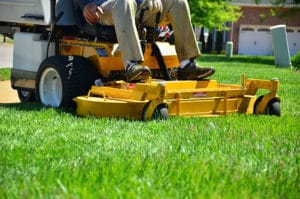Avoid the Scalp: How to Prevent Your Riding Mower from Scalping the Lawn
Avoid the Scalp: How to Prevent Your Riding Mower from Scalping the Lawn
Attention
Are you tired of dealing with a patchy and uneven lawn after using your riding mower? Do you find yourself frustrated by the unsightly scalps inflicted by your machinery? Look no further, as we unveil the secrets to preventing your riding mower from scalping your lawn.
Interest
Scalping, a common phenomenon faced by many lawn owners, occurs when the riding mower cuts the grass too low, resulting in bare spots and an overall messy appearance. It not only ruins the look of your lawn, but it can also weaken the grass, making it more vulnerable to diseases and weed invasion.
In this comprehensive guide, we will explore the various causes of riding mower scalping and provide you with effective solutions to ensure a pristine and healthy lawn all year round. Don't let your precious turf suffer any longer.
Desire
Imagine the satisfaction of gliding effortlessly over your lawn, confident that your riding mower is cutting at the perfect height, leaving behind a lush and well-manicured carpet of green. Envision the envy of your neighbors as they marvel at the impeccable landscape you cultivate.
By adopting the preventive measures we're about to reveal, you can take control of your lawn maintenance routine and transform your once-scalped yard into a masterpiece that will be the envy of the neighborhood.
Action
Ready to embark on this journey towards a scalping-free lawn? Let's dive in and explore the steps you can take to prevent your riding mower from causing havoc on your precious grass.
1. Adjust the Mower Height

One of the primary reasons for scalping is a mower blade set too low. Ensure that your riding mower is set to the appropriate cutting height for the type of grass you have in your lawn. Different grass varieties have different optimal cutting heights, so make sure to research which height works best for your specific type.
To avoid scalping, gradually increase the cutting height over time. A good rule of thumb is to never remove more than one-third of the grass blade length in a single mowing session. By raising the mower deck, you allow the grass to maintain its desired length, preventing scalping.
2. Level Uneven Surface
Uneven terrain can contribute to scalping as the mower blade comes into contact with lumps and bumps in the ground. Take the time to level out any uneven surfaces in your lawn to create a smooth and even landscape.
You can achieve this by filling depressions with soil and removing any high spots. Regularly roll or pack the ground to even out the surface and minimize the chances of scalping.
3. Avoid Mowing Wet Grass
Mowing wet grass not only leads to clumping and uneven cuts, but it can also increase the likelihood of scalping. The wetness causes the grass blades to bend, making it difficult for the mower blade to cut them evenly.
Wait until the grass blades are dry before mowing to obtain the best results. Early morning is usually the ideal time to mow as the grass has had time to dry from the morning dew.
4. Choose the Right Tires
Believe it or not, your choice of tires can have an impact on the scalping issue. The type of tire on your riding mower affects the machine's weight distribution, traction, and ability to navigate various terrains.
Opt for wide and appropriately inflated tires that distribute the mower's weight evenly. This helps prevent the mower deck from sinking into the grass, minimizing the risk of scalping.
5. Maintain a Regular Mowing Schedule
Neglecting your lawn for prolonged periods can lead to overgrowth, which in turn increases the chances of scalping. Regularly mowing your lawn at the recommended intervals ensures the grass remains at the desired height, reducing the risk of scalping in the future.
Set a schedule that suits your grass type, weather conditions, and growth rate, and stick to it. Consistency is key to maintaining a healthy and visually appealing lawn.
6. Keep the Blades Sharp
Dull mower blades tear the grass instead of cleanly cutting it, resulting in an uneven and damaged lawn. Regularly inspect and sharpen your mower blades to ensure they are in prime condition.
Experts recommend sharpening the blades at least once a year or whenever you notice signs of tearing, fraying, or ragged grass tips. Sharp blades make clean cuts and minimize stress on the grass, preventing scalping and promoting a healthier lawn.
7. Be Mindful of Speed
Speeding through your mowing sessions might seem efficient, but it can contribute to scalping. As you increase the speed, the mower blade might not have enough time to react and adjust to uneven terrain, intensifying the risk of scalping.
Take it slow and steady, allowing the mower to adapt to the changes in the lawn's topography. This mindful approach prevents scalping and ensures a more even trim.
By following these pro tips and implementing them into your lawn care routine, you can bid farewell to scalping and welcome a perfectly manicured lawn that will impress and inspire. Take control of your riding mower and transform it into a reliable ally in your quest for a picture-perfect yard.
Post a Comment for "Avoid the Scalp: How to Prevent Your Riding Mower from Scalping the Lawn"